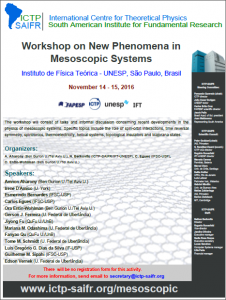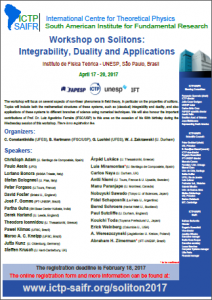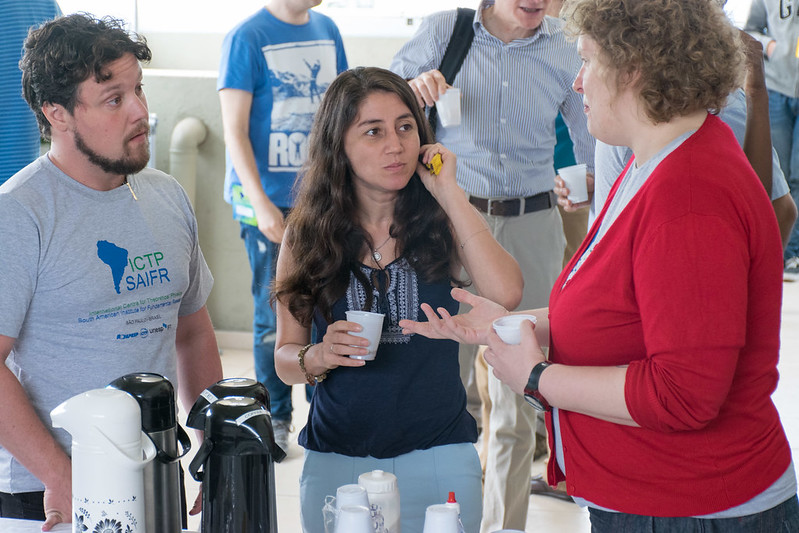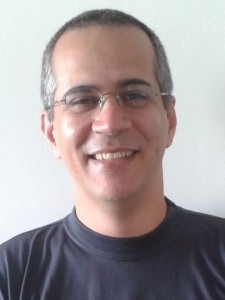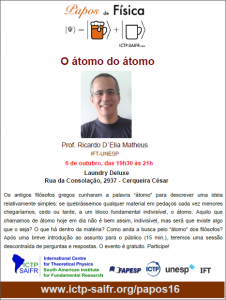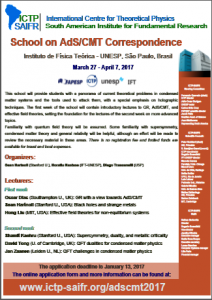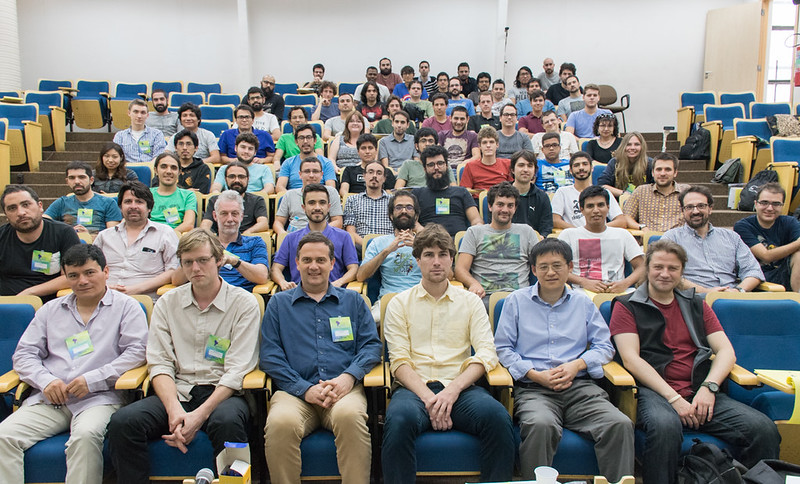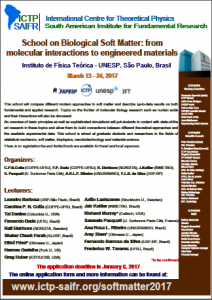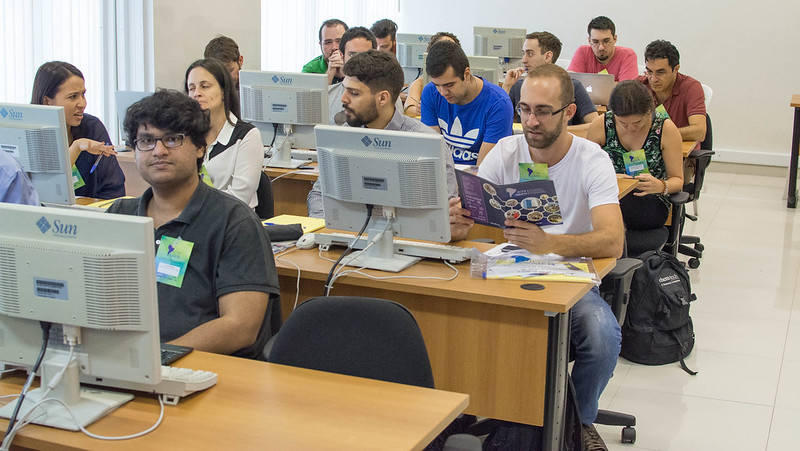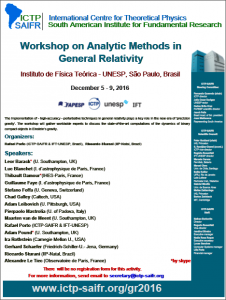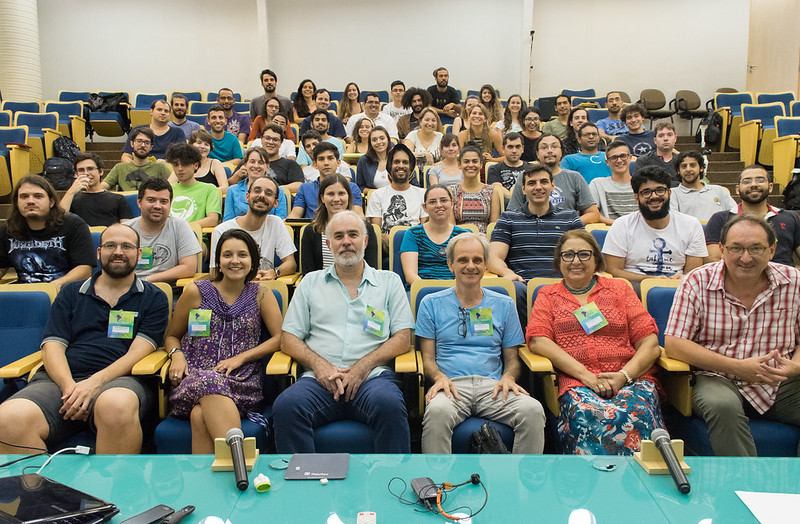Search Results
Workshop on New Phenomena in Mesoscopic Systems
![]()
Start time: November 14, 2016
Ends on: November 15, 2016
Location: São Paulo, Brazil
Venue: IFT-UNESP
Organizers:
- Amnon Aharony (Ben Gurion U./Tel Aviv U., Israel)
- Carlos Egues (IFSC-USP, Brazil)
- Ora Entin-Wohlman (Ben Gurion U./Tel Aviv U., Israel)
Speakers:
- Amnon Aharony (Ben Gurion U./Tel Aviv U., Israel): Time reversal symmetry breaking, Spin-orbit interactions and spintronics
- Irene D’Amico (University of York, UK): SSH-type spin chains: coherence and dynamics of topologically protected localized states
- Esmerindo Bernardes (IFSC-USP, Brazil): k.p model for ideal wurtzite quantum wells
- Carlos Egues (IFSC-USP, Brazil): Persistent skyrmion lattice of non-interacting electrons in spin-orbit coupled wells
- Ora Entin-Wohlman (Ben Gurion U./Tel Aviv U., Israel): Enhanced performance of three-terminal thermoelectric devices
- Gerson J. Ferreira (U. Federal de Uberlândia, Brazil): Spin drift and diffusion in one- and two-subband helical systems
- Jiyong Fu (QuFu University, China and UnB, Brazil): Valley Zeeman energy in monolayer MoS2 quantum rings
- Mariana M. Odashima (U. Federal de Uberlândia, Brazil): Time-dependent resonant tunneling transport: partitioned and non-partitioned schemes
- Fanyao Qu (UnB, Brazil): Topological engineering of many-body quantum phenomena in novel Van der Waals crystals
- Tome M. Schmidt (U. Federal de Uberlândia, Brazil): Protected States in 2D Topological Insulators
- Luis Gregório G. Dias da Silva (IF-USP, Brazil): The role of impurity symmetries in graphene electron transport
- Guilherme M. Sipahi (IFSC-USP, Brazil): Realistic k.p band structure and spin properties: modeling spin lasers and spin splitting in nanowires
- Edson Vernek (U. Federal de Uberlândia, Brazil): Majorana vs Andreev bound states in quantum dot systems
Description:
The workshop will consist of talks and informal discussion concerning recent developments in the physics of mesoscopic systems. Specific topics include the role of spin-orbit interactions, time reversal symmetry, spintronics, thermoelectricity, helical systems, topological insulators and Majorana states. There will be no registration form for this activity and for more information please send E-mail to secretary@ictp-saifr.org.
Poster
Photos:
- click here
Workshop Program: PDF updated on November 1
| Start | End | Nov. 14 – Monday | Nov. 15 – Tuesday | ||
| 8:30 | 9:00 | REGISTRATION | |||
| 9:00 | 9:45 | Amnon Aharony (video) | Time reversal symmetry breaking, Spin-orbit interactions and spintronics | Mariana M. Odashima (video) | Time-dependent resonant tunneling transport: partitioned and non-partitioned schemes |
| 9:45 | 10:30 | Irene D’Amico (video) | SSH-type spin chains: coherence and dynamics of topologically protected localized states | Jiyong Fu (video) | Valley Zeeman energy in monolayer MoS2 quantum rings |
| 10:30 | 10:45 | COFFEE BREAK | |||
| 10:45 | 11:30 | Esmerindo Bernardes (video) | k.p model for ideal wurtzite quantum wells | Tome M. Schmidt (video) | Protected States in 2D Topological Insulators |
| 11:30 | 12:15 | Carlos Egues (video) | Persistent skyrmion lattice of non-interacting electrons in spin-orbit coupled wells | Luis Gregório G. Dias da Silva (video) | The role of impurity symmetries in graphene electron transport |
| 12:15 | 14:15 | LUNCH | |||
| 14:15 | 15:00 | Ora Entin-Wohlman (video) | Enhanced performance of three-terminal thermoelectric devices | Guilherme M. Sipahi (video) | Realistic k.p band structure and spin properties: modeling spin lasers and spin splitting in nanowires |
| 15:00 | 15:45 | Gerson J. Ferreira (video1 at 0:55:20) (video 2 until 0:40:00) | Spin drift and diffusion in one- and two-subband helical systems | Edson Vernek (video) | Majorana vs Andreev bound states in quantum dot systems |
| 15:45 | 16:30 | Fanyao Qu (video at 0:40:15) | Topological engineering of many-body quantum phenomena in novel Van der Waals crystals |
COFFEE BREAK and Discussions
|
|
| 16:30 | 18:00 | COFFEE BREAK and Discussions | |||
Continue Reading |
Comments Off on
Workshop gratuito para professores do ensino médio
Atividades ocorreram dias 17 e 18 de setembro
Por Assessoria de Comunicação e Imprensa/UNESP
Dias 17 e 18 de setembro, o ICTP-SAIFR (Instituto Sul-Americano para Pesquisa Fundamental) organizou, no Instituto de Física Teórica (IFT) da Unesp, em São Paulo, SP, no bairro da Barra Funda, um workshop Cutting-edge In-class Physics Resources para professores do ensino médio em parceria com o Perimeter Institute (PI) for Theoretical Physics. O workshop foi gratuito e em inglês.
Fotos de Lucas Sanches das atividades disponíveis em
https://www.flickr.com/photos/93319111@N04/sets/72157670776292003
Criado em 1999, o instituto canadense é uma referência internacional em pesquisa no campo da física teórica e mantém vinculo próximo com diversas universidades canadenses, especialmente com a Universidade de Waterloo. O centro também se destaca pela atuação no campo da extensão, com eventos que focam educação e promovam a aproximação de temas da Física com o público leigo
“Somos um instituto que faz pesquisa, mas temos este forte componente de divulgação científica que foge um pouco do perfil típico de um centro de pesquisa. Organizamos muitas palestras cientificas para o público leigo e desenvolvemos diversos materiais didáticos relacionados à Física”, explica Greg Dick, Director of Educational Outreach do PI. “Já atingimos 5 milhões de alunos e 15 mil professores”. Mais informações sobre o Instituto em: https://www.perimeterinstitute.ca/
“Foi uma ótima experiência com os professores de ensino médio brasileiros, que trouxeram relevantes questões e participaram ativamente das propostas durante todo o final de semana”, apontou Glenn Wagner, que ministrou atividades durante o evento.
Participaram do curso no IFT 42 professores de ensino médio das redes pública e privada. “Foi uma excelente experiência para discutir questões atuais de Física Teórica de modo que possamos levar para as nossas salas de aula”, comentou Danilo Claro Zanardi, professor de Física do Colégio Dante Alighieri. “Muito do que estamos disctindo aui vamos levar para as nossas aulas”, acrescentou Elizabeth Zaki, professora do Colégio Santa Cruz. “É uma importante oportunidade de atualizarmos nosso conhecimentos e ações didáticas”, diz Miriam S. Rosenfeld, da Escola Estadual Maria José.
“Os materiais utilizados são disponibilziados gratuitamente na internet, inclusive com a possibilidade de serem editados pelos professores. Um de nossos próximos objetivos é realizar a traduação para a língua portuguesa. Também queremos repetir este tipo de ação no próximo ano”, informou Nathan Berkovits, que integra o ICTP-SAIFR e o IFT – Unesp.
Veja abaixo o programa que foi enfocado:
Descrição
Perimeter resources bring challenging modern physics concepts – including wave-particle duality, dark matter, astronomy, and particle physics – to life using a mix of hands-on activities, rich video, and other creative approaches. You will each get the full suite of classroom-ready, modifiable resources that have been correlated with the Science Standards of São Paulo State, for you to share with your students for free.
DAY 1
Registration
10am Classical & Modern Physics (Dark Matter)
1:00pm Lunch
2:30pm Quantum (Wave-Particle Duality). Hands-On Exploration & Lab
5:00pm Plank’s Constant Lab. Questions and Discussion
5:30pm Participants depart
DAY 2
10am Process of Science & Exploration of Models. Cosmology
1:00pm Lunch
2:30pm PI Engagement
3:00pm Black Holes & What’s Next? Particle Physics. What’s new in Physics.
5:15pm Final Questions
5:30pm Thank you and departure
Mais informações: secretary@ictp-saifr.org
Continue Reading | Comments Off on Workshop gratuito para professores do ensino médio
Workshop on Solitons: Integrability, Duality and Applications
April 17 – 20, 2017
São Paulo, Brazil
ICTP-SAIFR/IFT-UNESP
![]()
Home
Description:
The workshop will focus on several aspects of non-linear phenomena in field theory, in particular on the properties of solitons. Topics will include both the mathematical structures of these systems, such as (classical) integrability and duality, and also applications of these systems to different branches of science using numerical techniques. We will also honour the important contributions of Prof. Dr. Luiz Agostinho Ferreira (IFSC/USP) to this area on the occasion of his 60th birthday during the Wednesday session of this workshop. There is no registration fee.
Additional information can be found here
Organizers:
- Betti Hartmann (IFSC/USP, Brazil)
- Clisthenis Constantinidis (UFES-Vitória, Brazil)
- Gabriel Luchini (UFES-Vitória, Brazil)
- Wojtek J. Zakrzewski (University of Durham, UK)
Participants
SPEAKERS
- Abraham H. Zimerman – IFT-UNESP São Paulo, Brazil (confirmed)
- Adalto Rodrigues Gomes dos Santos – Universidade Federal do Maranhão, Brazil (confirmed)
- Alexis Roa Aguirre – Universidade Federal de Itajubá, Brazil (confirmed)
- Andrzej Wereszczynski -Jagiellonian University Krakov, Poland (confirmed)
- Árpád Luk-TU Delft, The Netherlands (confirmed)
- Carlos Naya – University of Durham, England (confirmed)
- Christoph Adam – University of Santiago de Compostela, Spain (confirmed)
- David Foster – Bristol University, England (confirmed)
- Fidel Schaposnik – La Plata University, Argentina (confirmed)
- Floris ter-Braak – Durham University, England (confirmed)
- Gabriel Luchini – UFES-Vitória, Brazil (confirmed)
- Gianni Tallarita – Universidad Adolfo Ibáñez, Chile (confirmed)
- Gustavo Moreira Simões – Universidade Federal Fluminense, Brazil (confirmed)
- José F. Gomes – IFT-UNESP São Paulo, Brazil (confirmed)
- Jutta Kunz – University of Oldenburg, Germany (confirmed)
- Kouichi Toda – Toyama Prefectural University, Japan (confirmed)
- Manu Paranjape – University of Montreal, Canada (confirmed)
- Marco Aurelio C. Kneipp – Universidade Federal de Santa Catarina, Brazil (confirmed)
- Nobuyuki Sawado – Tokyo University of Science, Japan (confirmed)
- Partha Guha – SN Bose Center Kolkata, India (confirmed)
- Paul Sutcliffe – University of Durham, England (confirmed)
- Pawel Klimas – Universidade Federal de Santa Catarina, Brazil (confirmed)
- Peter Forgacs – University of Tours, France (confirmed)
- Stefano Bolognesi – University of Pisa, Italy (confirmed)
- Steffen Krusch – University of Kent at Canterbury, UK (confirmed)
- Stephen Flood – University of Leeds, England (confirmed)
- Theodora Ioannidou – Aristotle University at Thessaloniki, Greece (confirmed)
- Wojtek J. Zakrzewski – University of Durham, UK (confirmed)
- Yuki Amari – Tokyo University of Science, Japan (confirmed)
POSTER Presentations
- Ana Lúcia Retore – IFT-UNESP, Brazil (confirmed)
- Fabiano de Carvalho Simas – Universidade Federal do Maranhão, Brazil (confirmed)
- Harold Sócrates Blas Achic – Universidade Federal de Mato Grosso, Brazil (confirmed)
- Ivan Antonio Cardenas Munoz – Universidad de Sonora, Mexico (confirmed)
- Luís Rodolfo Santos Filho – CBPF, Brazil (confirmed)
- Masaya Iida – Tokyo University of Science, Japan (confirmed)
- Nathaly Infantini Spano – IFT-UNESP, Brazil (confirmed)
- Rodolfo Alvan Casana Sifuentes – Universidade Federal do Maranhão, Brazil (confirmed)
ADDITIONAL PARTICIPANTS
- Alberto Saa – Universidade de Campinas, Brazil
- André Correia Riserio do Bonfim – Universidade Federal do Mato Grosso, Brazil
- Andrés Felipe Vásquez Tocora- IFT-UNESP, Brazil
- Azadeh Mohammadi – Federal University of Campina Grande, Brazil
- Balbino José da Silva Pomponet Filho – Universidade Federal da Bahia, Brazil
- Bernardo Correa Amorim – Universidade Federal do Espírito Santo, Brazil
- Carlos Eduardo da Hora Santos – Universidade Federal do Maranhão, Brazil
- Carlos Felipe dos Santos Pereira – Universidade Federal do Espírito Santo, Brazil
- Carolina Luzes Marcos – Universidade Federal do Espírito Santo, Brazil
- Caroline-Laure Mbakob Tchouawou – African Institute for Mathematical Science, Cameroon
- Christian Gyaman – Ghana Atomic Energy Commission, Ghana
- David Rosa Junior – Universidade Federal Fluminense, Brazil
- Etevaldo dos Santos Costa Filho – Universidade Federal do Espírito Santo, Brazil
- Felipe Cônsole – IFSC/USP, Brazil
- Felipe Monteiro de Amorim – CBPF Rio, Brazil
- Francisco Castilho Alcaraz – IFSC/USP, Brazil
- Gabriel Vieira Lobo – IFT-UNESP, Brazil
- Georgios Itsios – IFT-UNESP, Brazil
- Isabela Crespo Januario de Olivera – Universidade Federal do Espírito Santo, Brazil
- Javier Peraza Martiarena – Uruguay
- Jogean Matheus Carvalho Ferreira – IFT-UNESP, Brazil
- Jordany Vieira de Melo – Universidade Federal do Espírito Santo, Brazil
- Luis Esteban Oxman – Universidade Federal Fluminense, Brazil
- Majid Dehghani – Yazd University, Iran
- Manuela Carvalho de Almeida – IF/USP, Brazil
- Marcelo Camargo de Juli – Universidade Presbiteriana Mackenzie, Brazil
- Maria Daniela Leite de Souza – CBPF Rio, Brazil
- Maria de Lourdes Zamboni Peixoto Deglmann – Universidade Federal de Santa Catarina, Brazil
- Marzia Petrucci – IFT-UNESP, Brazil
- Nathália Pio Aprile – IFSC/USP, Brazil
- Patchali Tchilabalo Essossimna – University of Ibadan, Nigeria
- Raju Roychowdhury – IF-USP, Brazil
- Rogerio Gregorio Burgugi – USP São Paulo, Brazil
- Ryo Suzuki – ICTP-SAIFR, Brazil
- Sebastián Enrique Acevedo Espinoza – Universidad Andrés Bello, Chile
- Segundo Parra Milián – IFT-UNESP, Brazil
- Shota Yanai – Tokyo University of Science, Japan
- Silvia Guimarães Suzart Silva – Universidade Federal do Espírito Santo, Brazil
- Ulysses Camara da Silva – Universidade Federal do Espírito Santo, Brazil
- Victor César Costa Alves – IFT-UNESP, Brazil
- Victor Ignacio Afonso -Universidade Federal de Campina Grande, Brazil
Poster
Program
Workshop Program: PDF version (updated on April 19, 2017)
Vídeos:
Monday, April 17: (10:30 – 11:50), (12:20 – 13:40), (15:30 – 16:50), (17:20 – 18:40)
Tuesday, April 18: (10:30 – 11:50), (12:20 – 13:40), (15:30 – 16:50), (17:20 – 18:40)
Wednesday, April 19: (10:00 – 11:10), (11:40 – 13:00), (14:00 – 15:30)
Thursday, April 20: (10:30 – 11:50), (12:20 – 13:00), (14:30 – 15:30)
Photos
Additional Information
Continue Reading |
Comments Off on
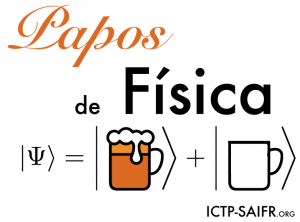
O átomo do átomo
Ricardo D’Elia Matheus
06 de outubro, das 19h30 ás 21h
Local: Laundry Deluxe – Rua da Consolação, 2937, Cerqueira César
Os antigos filósofos gregos cunharam a palavra “átomo” para descrever uma ideia relativamente simples: se quebrássemos qualquer material em pedaços cada vez menores chegaríamos, cedo ou tarde, a um bloco fundamental indivisível, o átomo. Aquilo que chamamos de átomo hoje em dia não é bem assim, indivisível, mas será que existe algo que o seja? O que há dentro da matéria? Como anda a busca pelo “átomo” dos filósofos?
SOBRE:
O Papos de Física surge como uma oportunidade para entrar em contato com temas relevantes e as mais recentes descobertas científicas na área de física. Com seminários curtos (15-20 min) seguido de debates, esta atividade será feita de forma descontraída e com conteúdo acessível ao público.
O PALESTRANTE:
Ricardo D Elia Matheus é professor do Instituto de Física Teórica da UNESP e suas áreas de interesse são física além do modelo padrão e espectroscopia de hádrons. Ricardo constrói modelos a partir de técnicas inspiradas na correspondência AdS/CFT para estudar teorias fortemente acopladas, que são extensões do modelo padrão na escala TeV, e “estados exóticos” em cromodinâmica quântica (QCD).
Poster
![]()
Continue Reading | Comments Off on
School on AdS/CMT Correspondence
March 27 – April 7, 2017
São Paulo, Brazil
ICTP-SAIFR/IFT-UNESP
![]()
Home
This school will provide students with a panorama of current theoretical problems in condensed matter systems and the tools used to attack them, with a special emphasis on holographic techniques. The first week of the school will contain introductory lectures to GR, AdS/CMT, and effective field theories, setting the foundation for the lectures of the second week on more advanced topics.
Familiarity with quantum field theory will be assumed. Some familiarity with supersymmetry, condensed matter theory and general relativity will be helpful, although an effort will be made to review the necessary material in these areas. There is no registration fee and limited funds are available for travel and local expenses.
Organizers:
- Sean Hartnoll (Stanford University, USA)
- Horatiu Nastase (IFT-UNESP, Brazil)
- Diego Trancanelli (USP, Brazil)
Satisfaction survey:
- click here
Lecturers
First week
Oscar Dias (Southampton University, UK): GR with a view towards AdS/CMT
In these lectures we will start with a nutshell introduction to General Relativity (GR) and in particular to GR in AdS spacetimes. This will be followed by another nutshell introduction, this time to the AdS/CFT correspondence which is the foundational building of the AdS/CMT correspondence that will be deeply studied during this school. Finally, we will introduce numerical methods to construct gravitational solutions, which are in particular tailored for AdS backgrounds of interest for the AdS/CMT correspondence.
Bibliography:
1) GR: http://200.145.112.247/QCD/reviewGR.pdf
[ for a full course on GR see e.g.: https://arxiv.org/abs/gr-qc/9712019 ]
2) AdS/CFT: https://arxiv.org/abs/1106.6073 + Chapter 1 of https://arxiv.org/abs/1612.07324 + Chapter 4 & 5 of https://arxiv.org/abs/1101.0618 + Chapters 8 & 9 of https://arxiv.org/pdf/0712.0689.pdf
3) Numerical methods: https://arxiv.org/abs/1510.02804 (in particular Chapters 3,4,6 & 7) + https://arxiv.org/abs/1107.5513
Sean Hartnoll (Stanford University, USA): Black holes and strange metals
Bibliography: Holographic quantum matter
Hong Liu (Massachusetts Institute of Technology – MIT, USA): Effective field theories for non-equilibrium systems
We will discuss formulation of hydrodynamics as a universal low energy effective field theory for a quantum many-body system. We will also provide a new proof of the second law of thermodynamics for systems in local equilibrium and show that such systems have an emergent supersymmetry.
References: arXiv:1511.03646, arXiv:1612.07705, arXiv:1701.07817, arXiv:1701.07445
Second week
Shamit Kachru (Stanford University, USA): Dualities and metallic criticality
I’ll talk about a variety of field theory dualities, old and new, that are of potential use in condensed matter physics. Then I will discuss one outstanding challenge for field theory techniques in condensed matter, that of understanding metallic criticality.
Bibliography: arXiv:1608.05077, arXiv:1609.02149, arXiv:1307.0004, arXiv:1312.3321 + textbook sources for review of older material, such as Fradkin’s “Field theories of condensed matter physics”.
David Tong (University of Cambridge, UK): Progress in d=2+1 Field Theories
Bibliography: Lectures on the Quantum Hall Effect, especially Section 5.
Jan Zaanen (Leiden U., The Netherlands): Quantum field theory challenges in condensed matter physics
These lectures will follow roughly the discussion in chapters 2, 3 and 14 in the book “Holographic duality in Condensed Matter Physics” by myself, Sun, Liu and Schalm (Cambridge Univ. Press, 2015). Additional background reading material will be indicated.
Lecture 1: General perspective: matter and quantum information. Short ranged entangled product states, spontaneous symmetry breaking and rigidity: review of the condensed matter textbooks. The strange rigidity of the Fermi liquid. (e.g. Nayak’s lecture notes: http://www.physics.ucla.edu/~nayak/many_body.pdf)
Lecture 2: Quantum field theory and bosons at a finite density. Weak-strong duality and the emergence of gauge fields. The strongly interacting quantum critical state: infinite party entanglement, the ETH and Planckian dissipation. Fermions and Herz-Millis. S. Sachdev, “Quantum Phase transitions” (CUP, 2011); Duality, arXiv:1108.2791, arXiv:1603.04254 (Zaanen);
Lecture 3: Macroscopic entanglement and topological order. Stripe- and Cooper-pair fractionalization versus the emergent gauge fields of string nets. The BCS superconductor as a Z2 spin liquid. Tensor networks. Fermionic entanglement in compressible systems: the nodal surface and the Mott collapse. String nets arXiv:1210.1281 (Wen); Tensor networks arXiv 1306.2164 (Orus); fermions arXiv:0802.2455, arXiv:1605.02477 (Zaanen). Mottness arXiv:0911.4070 (Zaanen).
Lecture 4: Condensed matter experiments and the intellectual crisis: the need for a new paradigm. A short history of high Tc superconductivity and other correlated electron systems. Mottness, stripyness and other complex behaviours versus the big numerical machines. The strange metals. History arXiv:1012.5461 (Zaanen); Cuprates, Nature 518, 179, 2015 (Keimer); Heavy fermions RMP 79, 1015, 2007 (Lohneisen); intertwined order arXiv:1407.4480 (Fradkin), arXiv:1701.00054 (Zheng)
Lecture 5: The lessons of holography as the mean field theory of maximal entanglement. Strange metals as emergent critical phases. Incoherent spectra and unparticle physics. Collective transport versus single particles: Planckian dissipation. The “dark matter” of holographic superconductors. What sets Tc’s?
Poster
Program
School Program: PDF version (updated on March 15, 2017)
Photos
Files & Exercises
Oscar Dias (Southampton University, UK): GR with a view towards AdS/CMT
Jan Zaanen (Leiden U., The Netherlands): Quantum field theory challenges in condensed matter physics
- String theorists need Eddington!
- The intertwined order of underdoped cuprates
- Mottness and the Emergent Fermi liquid
Short talks:
- Ignacio Reyes, “The phases of higher spin black holes”
- Carlos Bessa, “Analog Quantum Gravity Effects in Dielectrics”
- Raul Arias, “Spontaneous current in an holographic s+p superfluid”
- Bruno Loureiro, “Disorder in AdS/CMT”
- Ignacio Salazar Landea, “The g-theorem and quantum information theory”
- Alfredo Herrera Aguilar, “Ricci flows and possible applications to phase transitions in CMT”
- Jarkko Jarvela, “Non-relativistic anyonic holographic matter”
- Nicolas Kovensky, “On antisymmetric contributions to holographic DIS and the five-dimensional Chern-Simons term”
Additional Information
List of Confirmed Participants: Updated on March 22
Poster presentation: Participants who are presenting a poster MUST BRING THE POSTER PRINTED. The poster size should be at most 1,5m x 1m.
Registration: ALL participants should register. The registration will be on March 27 at the institute from 8:00 to 9:00 am. You can find arrival instructions at http://www.ictp-saifr.org/?page_id=195
Accommodation: Participants, whose accommodation has been provided by the institute will stay at The Universe Flat. Each participant, whose accommodation has been provided by the institute, has received the accommodation details individually by email.
BOARDING PASS: All participants, whose travel has been provided or will be reimbursed by the institute, should bring the boarding pass upon registration, and collect an envelope to send the return boarding pass to the institute.
Emergency number: 9 8233 8671 (from São Paulo city); +55 11 9 8233 8671 (from abroad), 11 9 8233 8671 (from outside São Paulo).
Ground transportation instructions:
Ground transportation from Guarulhos Airport to The Universe Flat
Ground transportation from Congonhas Airport to the Universe Flat
Ground transportation from The Universe Flat to the institute
Continue Reading |
Comments Off on
School on Biological Soft Matter: from molecular interactions to engineered materials
March 13 – 24, 2017
São Paulo, Brazil
ICTP-SAIFR/IFT-UNESP
![]()
Home
This school will compare different modern approaches to soft matter and describe up-to-date results on both fundamental and applied research. Topics on the frontier of molecular biology research such as nucleic acids and their interactions will also be discussed. An overview of basic principles as well as sophisticated simulations will put students in contact with state-of-the art research in these topics and allow them to build connections between different theoretical approaches and the available experimental data.
In addition to presenting posters, participants will be invited to give short talks on their research activity. This school is aimed at graduate students and researchers in the fields of statistical mechanics, materials science, biophysics and nanobiotechnology. There is no registration fee and limited funds are available for travel and local expenses.
Organizers:
- Carolina Palma Naveira Cotta (COPPE-UFRJ, Brazil)
- Fernando Pereira Duda (COPPE-UFRJ, Brazil)
- Ralf Eichhorn (NORDITA, Sweden)
- Jair Koiller (INMETRO, Brazil)
- Samuela Pasquali (U. Sorbonne Paris Cité, France)
- Ana Rosa Lopes Pereira Ribeiro (UNIGRANRIO, Brazil)
- Fernando Luís Barroso da Silva (USP-Ribeirão Preto, Brazil)
Satisfaction survey:
Lecturers
First week
The study of protein-protein interaction as seem by small-angle X-ray Scattering
Leandro Barbosa (USP-São Paulo, Brazil)
In this lecture I will discuss about the protein-protein interactions as seem by small-angle X-ray Scattering techniques using model proteins, such as Lysozyme and Serum Albumin at different concentrations and ionic strengths. Several alternative theoretical models will be presented to the students.
Synthetic Biology: From Microbial Genetic Circuits to New Therapies
Tal Danino (Columbia U., USA)
Rapid advances in the field of synthetic biology have enabled the design and construction of genetic circuits capable of generating programmed behavior in microbes. Concurrently, the last decade of microbiome research has revealed an astounding prevalence of microbes in diverse tissues previously thought to be sterile, such as solid tumors. These emergent fields have prompted the exploration of microbes as a natural platform for the development of engineered therapies and diagnostics. In this research talk, I will describe our progress towards a new design framework for engineering microbial gene circuits that bridges computational modeling and in vitro characterization, to diagnostic and therapeutic applications for cancer in vivo. This talk will begin with a description of bacterial gene circuits that generate synchronized oscillations, and will then describe development of programmed bacteria as both diagnostic and therapeutic agents for cancer.
Dynamics on the micro-scale: Brownian motion and electrokinetic effects
Ralf Eichhorn (NORDITA, Sweden)
This lecture will provide a basic introduction to particle motion in fluidic systems on the micrometer scale (and below), where thermal fluctuations play a noticeable role. We will introduce the standard model for Brownian motion to describe the diffusive component in the particle’s motion. Amongst the various deterministic driving forces, we will focus on electrohydrodynamic effects such as electrophoresis (particle motion due to an external electric field). If time permits, the latter will be extended to general phoretic transport phenomena.
Proteins and nucleic acids: basic concepts and challenges?
Shaker Chuck Farah (IQ-USP, Brazil)
Basic introduction to proteins and nucleic acids, discussing important challenges in this research fields from an experimental point of view?
Multiscale modeling of DNA
Aatto Laaksonen (Stockholm University, Sweden)
- Statistical Mechanics of soft and biological matter and modern computer modeling and simulation techniques
- Multi-scale computer simulations of structure and dynamics in canonical and non-canonical DNA. Modeling of DNA in chromatin.
- Coarse-grained simulations of structure and dynamics circular DNA. The effects from electrostatic interactions and importance of large cut-offs
The physics of nucleic acids
Samuela Pasquali (U. Sorbonne Paris Cité, France)
a. RNA/DNA systems, presentation of their structural features and role of ions
b. Modeling electrostatic interactions in nucleic acids : examples from selected articles
c. Coarse-grained force fields: proteins and nucleic acids
d. Advanced simulation techniques (REMD, ST, basing hoping MC, interactive simulations, …)
Peculiar electrostatic mechanisms observed in biomolecular systems
Fernando Luís Barroso da Silva (USP-Ribeirão Preto, Brazil)
On the peculiar electrostatic effects observed in protein systems – a computational approach
– Electrostatic interactions in and between molecules
- pKa calculations
– Ion-ion correlation and charge fluctuation mechanisms.
– Molecular modeling and Monte Carlo simulations
– Calcium binding proteins
– Protein-protein, protein-polyelectrolyte, protein-RNA and protein-nanoparticle interactions
The Electrostatic Effects in Colloid (and Protein) Thermodynamics
Frederico W. Tavares (UFRJ, Brazil)
Using Molecular Simulation, Density Functional Theory, and Poisson-Boltzmann equation to calculate ion concentrations close to charged and non-charged surfaces. Thermodynamics properties related to ion specificity, Hofmeister effects, size and electrostatic correlations. Application of these concepts to calculate protein adsorption on charged surfaces as a function of ion concentration, pH, ion type, and temperature.
Second week
Stimuli-responsive hydrogels
Fernando Duda (UFRJ, Brazil)
Stimuli-responsive hydrogels are cross-linked, macromolecular polymer networks embedded with water that may exhibit large, reversible, changes in volume, shape, permeability, mechanical properties, and surface characteristics in response to various environmental stimuli. They find applications in fields as diverse as microfluidics, biosensing, biocomputing, drug delivery, tissue engineering, and bone regeneration. In the particular field of cell culture, it was recently shown that, when subjected to electric fields, electro-responsive hydrogel-based scaffolds are able to impart dynamical loads that enhance longevity, proliferation and regulate differentiation of embedded adult stem cells.
The purpose of this lecture is to discuss and apply the principles of mechanics and thermodynamics to describe the complex behavior of stimuli-responsive hydrogels.
Cell biology and its mathematical tales, from the cell’s movement to its physiology
Hermes Gadelha (York U., UK)
A detailed look at the biological world generates endless untracked problems in fluid and solid mechanics. Cells and microorganisms endure in a variety of environments. Nodal cilia generate flows that are responsible for determining the normal asymmetry of the internal organs of the mammalian body; trypassonamitid infection use whip-like appendages to achieve propulsion. Microtubules assemblies supports the cytoskeleton mechanics and provide railways for fast and precise transport of proteins through mediated by the cell. Cellular membranes deform dynamically at the microscale and actively select the passage of molecules that are essential for sustaining life. We will explore how mathematical modelling and simulation can be used to shed new light in cellular biology, from locomotion of microorganisms and flagellates to cellular mechanics, its physiology and even cancer. This will be achieved by combining constructively concepts from solid and fluid mechanics to formulate simple but powerful elastohydrodynamic models. We will further demonstrate how the latter can be utilized to interpret paradoxical empirical observations. Finally, we highlight that this is a fertile and challenging area of inter-disciplinary research and demonstrate the importance of future observational and theoretical studies on the underlying mathematics of cellular biology.
Reference: BBC news, March 2017
Terasaki Ramps: A Glimpse into the Geometrical Architecture of the Cell
Greg Huber (KITP/UCSB, USA)
Biologists have long considered the endoplasmic reticulum (ER) to be an exceedingly important and complex intracellular organelle in eukaryotes. It is a membrane structure, part folded sheet, part branching network, that both envelopes the nucleus and threads its way outward, all the way to the cell’s periphery. Microscopic images attest to its convoluted geometry, but can the complexity of its architecture be understood in a precise, mathematical way? Recently, refined imaging of the ER has revealed beautiful and subtle geometrical forms – “Terasaki ramps” — suggestive of Riemann sheets and helical minimal surfaces. What is the physics of these structures, can it speak to their formation, and how do the structural motifs connect to biological function?
A gentle introduction to the mathematics of microswimming
Jair Koiller (INMETRO, Brazil)
Locomotion of microorganisms takes place in the Stokesian regime. The time independent incompressible Stokes equations are linear elliptic PDEs that can be studied by a variety of analytic and numerical methods. In our lectures we will describe some of those and we will also explain why optimal microswimming is a “gauge theory of something” (A. Shapere). We will look at some distinguished papers from the literature starting with Sirs G. I. Taylor and J.Lighthill in the 1950’s. Purcell’s “Life at low Reynolds number” will be discussed in detail. We will also look at some of the more recent contributions, specially on collective motion, locomotion on complex fluids, and situations were inertia still plays a role, eg. in acoustic streaming.
A biomimetic approach: from tissue regeneration to nanotoxicological models
Ana Rosa Lopes Ribeiro (UNIGRANRIO, Brazil)
The biomimetic approach represents a new strategy pursued in the field of human regenerative medicine, and the extracellular matrixes of animal tissues is a source of inspiration for biomaterial developments. Nowadays the existing biomaterials lack the inherent adaptability of natural tissues, they do not truly mimic the chemical and structural dynamic environment required fortissue regeneration. I will explore a biomimetic model from the morphological, chemical and biomechanical point of view and the studied concepts will be translated to the field of regenerative medicine. Also I will discuss the use of 3D in vitro models that mimic human physiological conditions, and explore the interactions of engineered nanomaterials with cells giving a glance at the nano – biointerface. The problems and challenges of the nanotoxicological field will be also discussed.
Poster
Program
School Program: PDF version (updated on March 16, 2017)
Files:
Jair Koiller
- A gentle introduction to the mathematics of microswimming
- A gentle introduction to the mathematics of microswimming – Notes and exercises
- Analysis of the Swimming of Microscopic Organisms; Geoffrey Taylor
Ana Ribeiro
Fernando Duda
By request of some lecturers, this material is available online only for participants.
Photos
Additional Information
List of Confirmed Participants: Updated on March 13
Poster presentation: Participants who are presenting a poster MUST BRING THE POSTER PRINTED. The poster size should be at most 1,5m x 1m.
Registration: ALL participants should register. The registration will be on March 13 at the institute from 8:30 to 9:30 am. You can find arrival instructions at http://www.ictp-saifr.org/?page_id=195
Accommodation: Participants, whose accommodation has been provided by the institute will stay at The Universe Flat. Each participant, whose accommodation has been provided by the institute, has received the accommodation details individually by email.
BOARDING PASS: All participants, whose travel has been provided or will be reimbursed by the institute, should bring the boarding pass upon registration, and collect an envelope to send the return boarding pass to the institute.
Emergency number: 9 8233 8671 (from São Paulo city); +55 11 9 8233 8671 (from abroad), 11 9 8233 8671 (from outside São Paulo).
Ground transportation instructions:
Ground transportation from Guarulhos Airport to The Universe Flat
Ground transportation from Congonhas Airport to the Universe Flat
Ground transportation from The Universe Flat to the institute
Continue Reading |
Comments Off on
III Dark Matter day in São Paulo
![]()
October 25, 2016
ICTP-SAIFR, São Paulo, Brazil
IFT-UNESP, Room 3
Description:
The goal of this meeting is to bring together everybody -student, researcher, professor- who is active (or simply interested) in the field of Dark Matter, and and is somehow close to the state of São Paulo. By gathering together theorists, experimentalists and astrophysicists, we continue with this third edition in the path to create a functional DM community in South America.
Submitting a contribution
If you would like to give a talk, submit a title and abstract writing to the organizers F.Iocco and M.Vecchi by October 10th at the latest. For more information please send E-mail to secretary@ictp-saifr.org
See webpage of 2015 edition for an idea of the content and format of the event.
Photos:
- click here
Program: PDF
Participants:
- Ivone Albuquerque (USP)
- Cristian Caniu Barres (USP)
- Alexander S. Belyaev (Southampton U., UK)
- Maria Benito (IFT-UNESP)
- Nicolás Bernal (ICTP-SAIFR/IFT-UNESP)
- Enrico Bertuzzo (USP)
- Victor Barreto Braga (UFRJ)
- Andresa Campos (IFT-UNESP)
- Luciano Casarini (UFES)
- Maria Eugenia C. Catalan (IF-USP)
- Arman Esmaili (PUC-RJ)
- Sylvain Fichet (ICTP-SAIFR/IFT-UNESP)
- Keanu Ghorbanian (IFSC-USP)
- Fabio Iocco (ICTP-SAIFR & IFT-UNESP)
- Ekaterina Karukes (SISSA, Italy & ICTP-SAIFR)
- Diego Torres Machado (UFRJ)
-
Martin Makler (CBPF)
- João Torres de Mello Neto (UFRJ)
- Boris Panes (IF-USP)
- Maximo Ave Pernas (IFSC-USP)
- Eduardo Pontón (ICTP-SAIFR)
- Davi Rodrigues (UFES)
- Rogerio Rosenfeld (ICTP-SAIFR & IFT-UNESP)
- Beatriz Blanco Siffert (UFRJ)
- Leandro Berardo e Silva (IAG USP)
- Flavia Sobreira (UFABC)
- Clara Watanabe (UFRJ)
- Manuela Vecchi (IFSC-USP)
- Bruce Sanchez Vega (IFT-UNESP)
- Xiaohao You (UFRJ)
Organizers:
- Fabio Iocco (IFT-UNESP & ICTP-SAIFR)
- Manuela Vecchi (IFSC-USP)
Additional information:
Hotel Recommendations:
The Universe Flat
Rua Pamplona, 83 – Jardim Paulista – São Paulo
Rates: R$ 274 + 5% (single) or R$ 324 + 5% (double), this is a special rate for Unesp.
Reservation: In order to get this rate you have to send an email to secretary@ictp-saifr.org
Hotel webpage: http://www.intercityhoteis.com.br/hoteis/hotel-the-universe/
This is the main hotel of the workshop.
How to reach the institute from The Universe Flat: Click here
Paulista Flat
Alameda Campinas, 105 – Bela Vista – São Paulo
Rates: You can check the rates and availability here
Reservation: Directly with the hotel. A credit card will be requested.
Hotel webpage: http://www.paulistaflat.com.br/home
How to reach the institute from Paulista Flat: Click here
Paulista Wall Street Suites
Rua Itapeva, 636 – Bela Vista – São Paulo
Rates: You can check the rates and availability here
Reservation: Directly with the hotel. A credit card will be requested.
Hotel webpage: http://www.wallstreet.com.br/
How to reach the institute from Paulista Wall Street Suites: Click here
Turiassu Hotel
Rua Turiassu, 328 – Perdizes – São Paulo
Rates: You can check the rates here
Reservation: Here
Hotel Webpage: http://www.hotelturiassu.com.br
How to reach the institute from Turiassu Hotel: Click here
Ibis Budget Paulista
Rua da Consolação 2303 – Consolação – São Paulo
Rates: You can check the rates and availability here
Reservation: Directly with the hotel. A credit card will be requested.
Hotel Webpage: http://www.ibis.com/gb/hotel-5323-ibis-budget-sao-paulo-paulista/index.shtml
How to reach the institute from Ibis Budget Paulista: Click here
Red Monkey Hostel
Rua Vitorino Carmilo, 664 – São Paulo
Rates: You can check the rates here
Reservation: You can request the reservation through the email secretary@ictp-saifr.org or directly on their webpage.
Hostel webpage: http://www.redmonkeyhostel.com.br/
Hostel Alice
Rua Harmonia, 1275 – Vila Madalena – São Paulo
Rates: You can check the rates and availability here
Reservation: Directly with the hostel. A credit card will be requested.
Hostel webpage: http://www.hostelalice.com.br/site/br/
How to reach the institute from Hostel Alice: Click here–
Contact: secretary@ictp-saifr.org
Continue Reading |
Comments Off on
Workshop on Analytic Methods in General Relativity
Start time: December 5, 2016
Ends on: December 9, 2016
Location: São Paulo, Brazil
Venue: IFT-UNESP
Organizers:
- Rafael Porto (ICTP-SAIFR & IFT-UNESP, Brazil)
- Riccardo Sturani (International Institute of Physics – Natal, Brazil)
Confirmed participants include:
- Leor Barack* (University of Southampton, UK)
- Luc Blanchet (Institut d’astrophysique de Paris, France)
- Thibault Damour* (IHES-Paris, France)
- Guillaume Faye (Institut d’astrophysique de Paris, France)
- Stefano Foffa (University of Geneva, Switzerland)
- Adam Leibovich (University of Pittsburgh, USA)
- Tanguy Marchand (Institut d’astrophysique de Paris, France)
- Pierpaolo Mastrolia* (U. of Padova, Italy)
- Maarten van de Meent (University of Southampton, UK)
- Rafael Porto (ICTP-SAIFR & IFT-UNESP)
- Adam Pound* (University of Southampton, UK)
- Ira Rothstein (Carnegie Mellon University, USA)
- Gerhard Schaefer (Friedrich-Schiller-Universität Jena, Germany)
- Riccardo Sturani (International Institute of Physics – Natal, Brazil)
- Alexandre Le Tiec (Laboratoire de l’Univers et de ses Théories de l’ Observatoire de Paris, France)
*by skype
Description:
The implementation of —high-accuracy— perturbative techniques in general relativity plays a key role in the new era of ‘precision gravity’. The workshop will gather worldwide experts to discuss state-of-the-art computations of the dynamics of binary compact objects in Einstein’s gravity. There will be no registration form for this activity and for more information please send E-mail to secretary@ictp-saifr.org.
Workshop Program: updated on Dec. 5, 2016
| Start | End | Monday, Dec. 5 -ADM | Tuesday, Dec. 6 -Harmonic | Wednesday, Dec. 7 – EFT | Thursday, Dec. 8 – GSF | Friday, Dec. 9 |
| 9:45 | 11:15 | Thibault Damour (video) (PDF) | Guillaume Faye (video) | Ira Rothstein & Rafael Porto (video) | Leor Barak (PDF) & Adam Pound (PDF) (video) | Discussion |
| 11:15 | 11:45 | COFFEE BREAK | ||||
| 11:45 | 13:15 | Gerhard Schafer (video) | Tanguy Marchand (video)(PDF) | Stefano Foffa & Riccardo Sturani (video) | Marteen Van de Meent (video) | Discussion |
| 13:15 | 15:30 | LUNCH | ||||
| 15:30 | 17:00 | Gerhard Schafer (video) | Luc Blanchet (video) | Pierpaolo Mastrolia (video) | Alex Le Tiec (video)(PDF) | Discussion |
| 17:00 | 17:15 | COFFEE BREAK | ||||
| 17:15 | 18:45 | Discussion | Discussion | Adam Leibovich (video) | Discussion | Discussion |
Photos:
- click here
Feedback:
- click here
Poster
Continue Reading |
Comments Off on
VI Southern-Summer School on Mathematical Biology
January 16 – 27, 2017
São Paulo, Brazil
ICTP-SAIFR/IFT-UNESP
![]()
Home
This school is aimed at graduate students in Physics, Mathematics, Ecology and Epidemiology, having at least a basic knowledge of calculus and differential equations. The first week will be a basic course on population biology, which also includes modelling exercises. The second week will be an advanced school on up-to-date topics in ecology and evolution. Candidates may apply either for one or two weeks. Undergraduate students with exceptional records are also encouraged to apply. Limited funds are available for travel and local expenses. There is no registration fee.
Please note that acceptance cannot be taken for granted, as we expect a much higher number of applications than the maximum number of participants. We advise the candidates to carefully complete the application form, providing enough information for the selection committee to take a decision.
In order to have an idea of the kind of activities that take place during the course, please visit the home-page of the first four editions of this school at http://www.ictp-saifr.org/mathbio, http://www.ictp-saifr.org/mathbio2, http://www.ictp-saifr.org/mathbio3, http://www.ictp-saifr.org/mathbio4 and http://www.ictp-saifr.org/mathbio5.
Organizers:
- Marcus Aguiar (UNICAMP, Brazil)
- Marcel Clerc (Universidad de Chile)
- Roberto Kraenkel (IFT-UNESP, Brazil)
- Paulo Inácio Prado (USP/SP, Brazil)
Satisfaction survey:
- click here
Lecturers
First week
Introduction to Population Biology
Roberto Kraenkel (IFT-UNESP, Brazil):
1) single species dynamics
2) interacting species I: competition
3) interacting species II: predator-prey dynamics
4) models in epidemiology
5) spatial population dynamics
Second week
Evolution in spatially structured populations
Florence Débarre (Collège de France – Paris, France)
Most populations exhibit some form of spatial structure, for instance because they are subdivided, because the environment they live in is spatially heterogeneous, or also because there are limits to the distances than an individual can travel. In this series of courses, I will present different tools and methods to study evolution in spatially structured populations, and will show how to apply them to specific questions, such as the evolution of dispersal, or the evolution of social behavior.
Evolution of molecular phenotypes: from gene regulation to immune system
Armita Nourmohammad (Princeton University, USA)
Molecular phenotypes, such as gene expression or protein binding affinities are important targets of natural selection, and are often subject to time-dependent pressure form the environment. However, the map between encoding DNA sequences and molecular phenotypes is often too difficult to quantify. In these lectures, I will show that universality is an emerging property of complex phenotypes, which are encoded by multiple genomic loci. I will introduce a non-equilibrium framework for adaptive dynamics of such phenotypes in time-dependent environments, and between co-evolving populations. In time-dependent environments, changes in the environment drive the evolution of the species, but not vice versa. As an example, I will present strong evidence that adaptation dominates the evolution of gene expression levels in Drosophila. Co-evolving populations reciprocally affect the fitness of each other, acting as time-dependent environments with feedback. As an example, I will show evidence of co-adaptation between interacting cellular populations of HIV viruses and the antibody repertoire of a patient over the course of an infection. In particular, I discuss the conditions for emergence of broadly neutralizing antibodies, which are recognized as critical for designing an effective vaccine against HIV.
Mathematical Theory of Biological Invasions
Sergei Petrovskii (University of Leicester, United Kingdom)
Biological invasions – which is a generic name for the phenomena occurring after a new, “alien” species is introduced – is thought to be the second most serious threat to biodiversity worldwide. It is also a very practical problem as it causes billions of dollars of economic loss annually due to the direct damage to agriculture resulting from invasion of pests. Mathematical modelling is an efficient research tool to understand the dynamics of the alien species’ establishment and proliferation. I will consider a variety of modelling approaches and techniques that can be used to study this problem in different ecological context (e.g. homogeneous or heterogeneous environment, interspecific interactions etc.). The main focus will be on the factors that may affect the rate of spread, the spatial patterns arising in the wake of the spread, and the possibility of fighting the spread through biological control.
Physiologically structured population models: from numerical techniques to ecological insight
Andre de Roos (University of Amsterdam, The Netherlands)
Many problems in ecology and evolution revolve around the question how individual life history influences population and community dynamics or vice versa how the population and community setting influences selection and adaptation of individual life histories. Physiologically structured population models are well suited to address such questions as this class of models represents the reproduction, development and mortality of individuals during their life history as dependent on the state of the individual itself and the environment it lives in. These structured population models hence consistently translate the individual life history to the population level and in turn account for density dependent, population feedback on life history through changes in the environment that the individual experiences. In recent years, a general methodology has been developed to carry out demographic, equilibrium (bifurcation) and evolutionary analysis of physiologically structured population models, which in its simplest form boils down to the numerical evaluation of the Lotka-Euler integral equation for computing population growth rates. I will give an introduction to the general methodology and illustrate its application with a few examples.
Subsequently, I will discuss how physiologically structured population models have been used to develop novel and counterintuitive ecological theory about the population and community effects of ontogenetic development. Growth in body size is by far the most prominent aspect of the ontogenetic development that every individual goes through during its life history. Necessarily, development depends on the availability of food and thus indirectly on the feedback from population foraging. I will show that population models accounting for food-dependent growth in body size of individuals make predictions that are in line with the classical unstructured theory about population and community dynamics, only in case of ontogenetic symmetry in energetics, meaning that development and reproduction are limited to the same extent by food availability. In contrast, in case of ontogenetic asymmetry in energetics, when either development or reproduction is more food-limited than the other process, models that account for food-dependent development make different and counter-intuitive predictions, as it may, for example, result in positive relationships between population biomass and individual mortality. The body size effects on community structure are even more substantial when species have a complex life cycle and growth in body size hence leads to a change in resource use or habitat during ontogeny. I will provide an overview of possible consequences of ontogenetic development for community structure and show how they come about because the population size distribution changes with changes in the environmental conditions, like productivity or mortality.
Poster
Photos
Program
Group Wiksite:
- relevant information on group projects, lectures and tutorials. Click here
School Program: PDF version (updated on Dec. 21, 2016)
|
1st WEEK |
|||||||
| Monday, January 16 | Tuesday, January 17 | Wednesday, January 18 | Thursday, January 19 | Friday, January 20 | Saturday, January 21 | Sunday, January 22 | |
| 9:30 – 11:00 | Registration (at 9:00) | LECTURE II: Competition (video 1)(video 2) (PDF) | LECTURE III:Predation | Lecture IV: Epidemiology | Lecture V: Spatial Ecology (video1) (video2) (PDF) | Lecture VI: Bistability
and histeresys |
Group presentations (at 10:00) |
| 11:00 – 18:00 | LUNCH (at 11:30)GROUP WORK (at 13:30) | WORK ON PROJECTS (lunch and coffee breaks in between) | WORK ON PROJECTS (lunch and coffee breaks in between) | WORK ON PROJECTS (lunch and coffee breaks in between) | WORK ON PROJECTS (lunch and coffee breaks in between) | WORK ON PROJECTS (lunch and coffee breaks in between) | |
| 18:00 – 19:30 | PRESENTATIONS | Special Lecture | Bestiarium | ||||
|
2nd WEEK |
|||||||
| Monday, January 23 | Tuesday, January 24 | Wednesday, January 25 | Thursday, January 26 | Friday, January 27 | |||
| 10:30 – 12:10 | FREE | Petrovskii I | Débarre III | de Roos III | Petrovskii IV | ||
| 12:10 – 14:00 | LUNCH | ||||||
| 14:00 – 15:40 | Débarre I (video) (PDF) (at 15:00)
COFFEE BREAK (at 16:40) |
de Roos I | Petrovskii II(video) | Petrovskii III | de Roos IV | ||
| 15:40 – 16:10 | COFFEE BREAK | FREE | |||||
| 16:10 – 17:50 | Débarre II | de Roos II | Débarre IV | ||||
| 18:00 -19:30 | Nourmohammad II(video) (PDF) | ||||||
Group Presentations:
Additional Information
List of Confirmed Participants: Updated on January 6
Registration: ALL participants should register. The registration will be on January 16 at the institute from 9:00 to 10:00 am, for those who will start on the first week. And from 1:00 to 2:00pm on January 23, for those who will start on the second week. You can find arrival instructions at http://www.ictp-saifr.org/?page_id=195
Accommodation: Participants, whose accommodation has been provided by the institute will stay at The Universe Flat. Each participant, whose accommodation has been provided by the institute, has received the accommodation details individually by email.
BOARDING PASS: All participants, whose travel has been provided or will be reimbursed by the institute, should bring the boarding pass upon registration, and collect an envelope to send the return boarding pass to the institute.
Emergency number: 9 8233 8671 (from São Paulo city); +55 11 9 8233 8671 (from abroad), 11 9 8233 8671 (from outside São Paulo).
Ground transportation instructions:
Ground transportation from Guarulhos Airport to The Universe Flat
Ground transportation from Congonhas Airport to the Universe Flat
Ground transportation from The Universe Flat to the institute
Continue Reading |
Comments Off on
